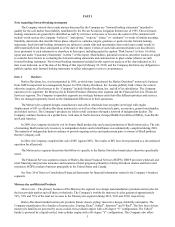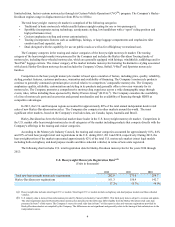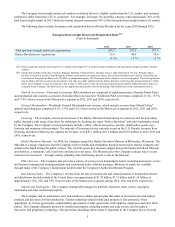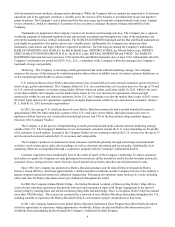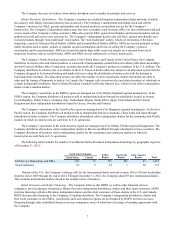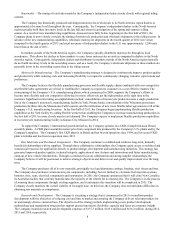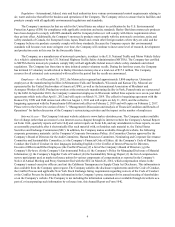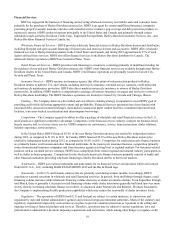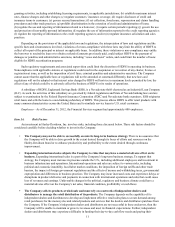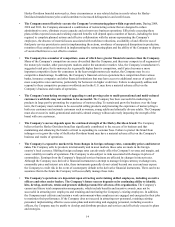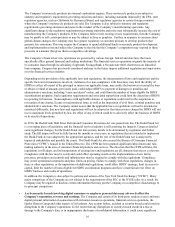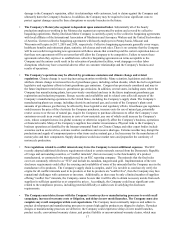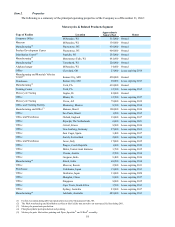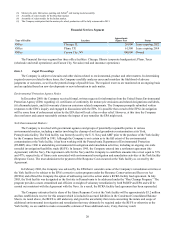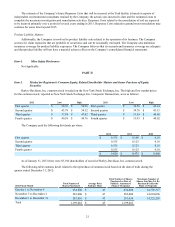Harley Davidson 2012 Annual Report Download - page 13
Download and view the complete annual report
Please find page 13 of the 2012 Harley Davidson annual report below. You can navigate through the pages in the report by either clicking on the pages listed below, or by using the keyword search tool below to find specific information within the annual report.13
• The Company and its independent dealers must successfully adjust to a more seasonal retail motorcycle sales
pattern. The Company records the wholesale sale of a motorcycle when it is shipped to the Company’s independent
dealers and distributors. The Company began flexible production at its York, Pennsylvania facility in the first half of
2013, which the Company expects will shift some motorcycle production to the first half of 2013 that did not occur in
the fourth quarter of 2012, to, among other things, address the seasonal retail sales cycle. Any difficulties in
implementing flexible production could result in lost production or sales. The Company and its independent dealers
and distributors must be able to successfully manage changes in production rates, inventory levels and other business
processes associated with flexible production. Failure by the Company and its independent dealers to make such
adjustments may have a material adverse effect on the Company’s business and results of operations.
• The Company relies on third party suppliers to obtain raw materials and provide component parts for use in
the manufacture of its motorcycles. The Company may experience supply problems such as unfavorable pricing or
untimely delivery of raw materials and components. In certain circumstances, the Company relies on a single supplier
to provide the entire requirement of a specific part, and a change in this established supply relationship may cause
disruption in the Company’s production schedule. In addition, the price and availability of raw materials and
component parts from suppliers can be adversely affected by factors outside of the Company’s control such as the
supply of a necessary raw material or natural disasters. Further, Company suppliers may experience difficulty in
funding their day-to-day cash flow needs because of tightening credit caused by financial market disruption. In
addition, adverse economic conditions and related pressure on select suppliers due to difficulties in the global
manufacturing arena could adversely affect their ability to supply the Company. These supplier risks may have a
material adverse effect on the Company’s business and results of operations.
• The Company relies on third party outsourcing companies to perform certain operating and administrative
functions. The Company has outsourced a number of operations to third parties in an effort to focus on competencies
that provide the Company a competitive advantage. Similar to suppliers of raw materials and components, the
Company may experience problems with outsourced services, such as unfavorable pricing, untimely delivery of
services, or poor quality. Also, outsourcing companies may experience adverse economic conditions due to difficulties
in the global economy that could lead to difficulties supporting the Company's operations. These service provider
risks may have a material adverse effect on the Company's business and results of operations.
• The Company’s financial services operations rely on external sources to finance a significant portion of its
operations. Liquidity is essential to the Company’s financial services business. Disruptions in financial markets may
cause lenders and institutional investors to reduce or cease to loan money to borrowers, including financial
institutions. The Company’s financial services operations may be negatively affected by the difficulty in raising capital
in the long-term and short-term capital markets. These negative consequences may in turn adversely affect the
Company’s business and results of operations in various ways, including through higher costs of capital, reduced funds
available through its financial services operations to provide loans to independent dealers and their retail customers,
and dilution to existing share value through the use of alternative sources of capital.
• The Company’s financial services operations are highly dependent on accessing capital markets to fund their
operations at competitive interest rates, the Company’s access to capital and its cost of capital are highly
dependent upon its credit ratings, and any negative credit rating actions will adversely affect its earnings and
results of operations. The ability of the Company and its financial services operations to access unsecured capital
markets is influenced by their short-term and long-term credit ratings. If the Company’s credit ratings are downgraded
or its ratings outlook is negatively changed, the Company’s cost of borrowing will increase, resulting in reduced
earnings and interest margins, or the Company’s access to capital may be disrupted or impaired.
• The Company’s financial services operations are exposed to credit risk on its retail and wholesale receivables.
Credit risk is the risk of loss arising from a failure by a customer to meet the terms of any contract with the Company’s
financial services operations. Credit losses are influenced by general business and economic conditions, including
unemployment rates, bankruptcy filings and other factors that negatively affect household incomes, as well as contract
terms, customer credit profiles and the new and used motorcycle market. Negative changes in general business,
economic or market factors may have an additional adverse impact on the Company’s financial services credit losses
and future earnings. While HDFS experienced historically low levels of retail credit losses during 2012, the Company
believes HDFS' retail credit losses may increase over time due to changing consumer credit behavior and HDFS'
efforts to increase prudently structured loan approvals in the near-prime and sub-prime lending environment. Credit
losses are also adversely impacted by increases in the frequency of loss and by decreases in the value of repossessed
Harley-Davidson branded motorcycles. If there are adverse circumstances that involve a material decline in values of


